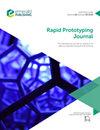3D bioprinting in the era of 4th industrial revolution – insights, advanced applications, and future prospects
IF 3.6
4区 工程技术
Q1 ENGINEERING, MECHANICAL
引用次数: 2
Abstract
Purpose The main objective of this paper is to illustrate an analytical view of different methods of 3D bioprinting, variations, formulations and characteristics of biomaterials. This review also aims to discover all the areas of applications and scopes of further improvement of 3D bioprinters in this era of the Fourth Industrial Revolution. Design/methodology/approach This paper reviewed a number of papers that carried evaluations of different 3D bioprinting methods with different biomaterials, using different pumps to print 3D scaffolds, living cells, tissue and organs. All the papers and articles are collected from different journals and conference papers from 2014 to 2022. Findings This paper briefly explains how the concept of a 3D bioprinter was developed from a 3D printer and how it affects the biomedical field and helps to recover the lack of organ donors. It also gives a clear explanation of three basic processes and different strategies of these processes and the criteria of biomaterial selection. This paper gives insights into how 3D bioprinters can be assisted with machine learning to increase their scope of application. Research limitations/implications The chosen research approach may limit the generalizability of the research findings. As a result, researchers are encouraged to test the proposed hypotheses further. Practical implications This paper includes implications for developing 3D bioprinters, developing biomaterials and increasing the printability of 3D bioprinters. Originality/value This paper addresses an identified need by investigating how to enable 3D bioprinting performance.第四次工业革命时代的3D生物打印——见解、先进应用和未来前景
目的本文的主要目的是对不同的三维生物打印方法、生物材料的变化、配方和特性进行分析。这篇综述还旨在发现3D生物打印机在第四次工业革命时代的所有应用领域和进一步改进的范围。设计/方法/方法本文综述了许多论文,这些论文对不同生物材料的不同3D生物打印方法进行了评估,使用不同的泵打印3D支架、活细胞、组织和器官。所有论文和文章都收集自2014年至2022年的不同期刊和会议论文。发现本文简要解释了3D生物打印机的概念是如何从3D打印机发展而来的,以及它如何影响生物医学领域,并有助于弥补器官捐献者的不足。它还对三个基本过程、这些过程的不同策略以及生物材料选择的标准进行了明确的解释。本文深入了解了如何通过机器学习辅助3D生物打印机,以扩大其应用范围。研究局限性/含义所选择的研究方法可能会限制研究结果的可推广性。因此,鼓励研究人员进一步检验所提出的假设。实际意义本文包括对开发3D生物打印机、开发生物材料和提高3D生物打印机可打印性的意义。独创性/价值本文通过研究如何实现3D生物打印性能来解决已确定的需求。
本文章由计算机程序翻译,如有差异,请以英文原文为准。
求助全文
约1分钟内获得全文
求助全文
来源期刊

Rapid Prototyping Journal
工程技术-材料科学:综合
CiteScore
8.30
自引率
10.30%
发文量
137
审稿时长
4.6 months
期刊介绍:
Rapid Prototyping Journal concentrates on development in a manufacturing environment but covers applications in other areas, such as medicine and construction. All papers published in this field are scattered over a wide range of international publications, none of which actually specializes in this particular discipline, this journal is a vital resource for anyone involved in additive manufacturing. It draws together important refereed papers on all aspects of AM from distinguished sources all over the world, to give a truly international perspective on this dynamic and exciting area.
-Benchmarking – certification and qualification in AM-
Mass customisation in AM-
Design for AM-
Materials aspects-
Reviews of processes/applications-
CAD and other software aspects-
Enhancement of existing processes-
Integration with design process-
Management implications-
New AM processes-
Novel applications of AM parts-
AM for tooling-
Medical applications-
Reverse engineering in relation to AM-
Additive & Subtractive hybrid manufacturing-
Industrialisation
 求助内容:
求助内容: 应助结果提醒方式:
应助结果提醒方式:


